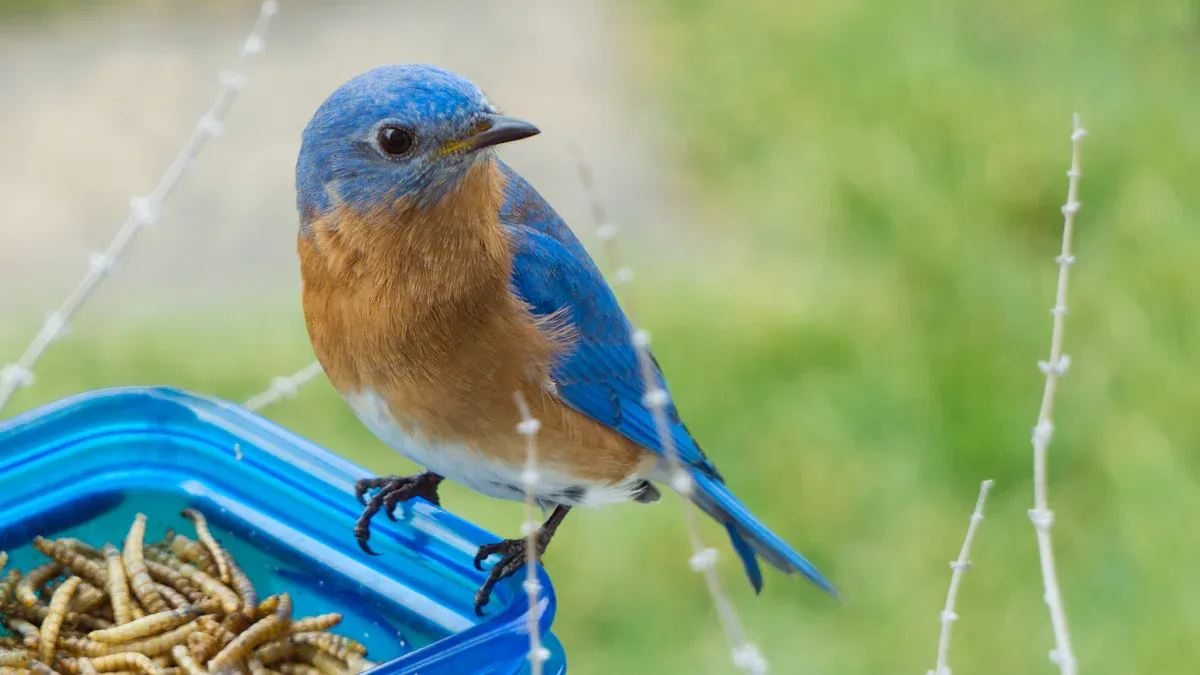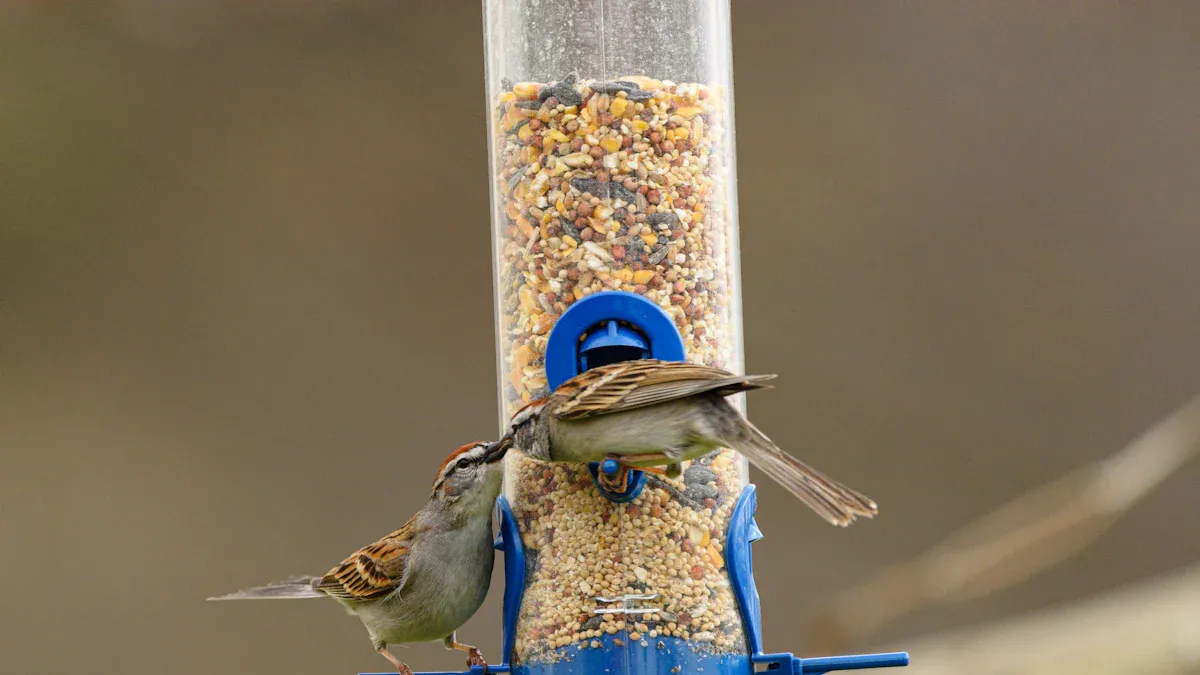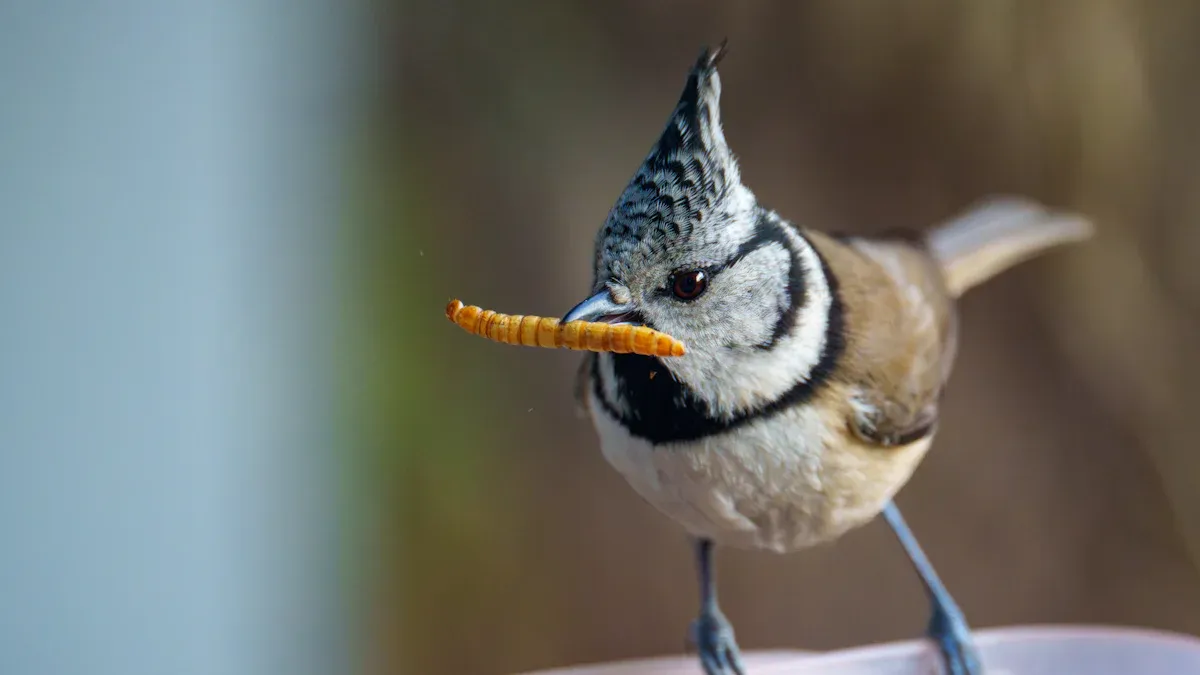
Mealworms are a game-changer for bird nutrition. Packed with 20-48% protein, they provide birds with the energy they need to thrive. Adding mealworms to their diet can boost natural behaviors like preening and foraging. Studies even show that birds fed mealworms experience less stress and better overall health. Plus, dried mealworms are incredibly versatile. They can be mixed with bird seed mealworms or offered alone, making feeding both easy and enjoyable.
Key Takeaways
- Mealworms are high in protein, giving 20-48% protein. This helps birds stay healthy, grow feathers, and have energy when needed.
- Dried mealworms are easy to use and store. They can be mixed with other foods or soaked in water for extra benefits.
- To keep birds healthy, feed mealworms in small amounts. Add seeds and fruits too, so birds get all the nutrients they need.
What Makes Mealworms Nutritious for Birds?

Nutritional Breakdown of Mealworms
Mealworms are packed with essential nutrients that birds need to stay healthy and active. Their composition includes high levels of protein, fats, and amino acids, making them a well-rounded food source. Here’s a closer look at their nutritional profile:
| Nutrient Type | Percentage Breakdown |
|---|---|
| Protein | 20% |
| Fat | 15% |
| Amino Acids | 35-50% of protein |
This nutrient-rich makeup supports birds during critical periods like molting, migration, and breeding. Whether you’re feeding wild birds or pet birds, mealworms provide the energy and building blocks they need to thrive.
Benefits of Protein, Fats, and Amino Acids
Protein is the cornerstone of bird health. It helps birds grow feathers, repair tissues, and produce eggs. Mealworms contain nearly 50% protein, making them an excellent choice during molting seasons when birds need extra protein to regrow feathers.
The fats in mealworms offer a concentrated energy source, especially useful for migratory birds that travel long distances. Amino acids, the building blocks of protein, are highly digestible in mealworms. Studies show that most amino acids in mealworms exceed 90% digestibility, ensuring birds get the maximum nutritional benefit.
- Mealworms are high-quality protein sources that enhance avian health.
- A small serving of mealworms can significantly boost protein intake, aiding in egg production and overall vitality.
- Their amino acid composition supports muscle development and feather growth, making them ideal for birds of all ages.
Why Dried Mealworms Are a Convenient Option
Dried mealworms are a game-changer for bird feeding. They retain the nutritional value of live mealworms while offering unmatched convenience. Here’s why they’re a favorite among bird enthusiasts:
- They can be stored for long periods without losing their nutritional quality.
- Dried mealworms can be mixed with bird seed mealworms, fruits, or suet pellets to create a balanced diet.
- They’re easy to use—place them in feeders, sprinkle them on the ground, or mix them with other foods to attract a variety of bird species.
Additionally, dried mealworms can be rehydrated by soaking them in warm water for 10-15 minutes, making them even more versatile. Their shelf life and ease of use make them perfect for year-round feeding, whether you’re catering to backyard birds or exotic species.
Birds That Benefit from Mealworms
Common Backyard Birds That Eat Mealworms
Many backyard birds enjoy mealworms as part of their diet. Species like bluebirds, robins, and chickadees are known to flock to feeders offering mealworms. Studies show that birds actively seek out mealworms, even in controlled environments. Researchers have observed that mealworms mimic overwintering arthropods, making them a natural and appealing food source for birds. Additionally, areas with bird feeders often see a reduction in mealworm numbers, further proving their popularity among backyard birds.
Seasonal and Migratory Birds
Mealworms are especially beneficial for seasonal and migratory birds. During migration, birds need high-energy foods to sustain their long journeys. The fats and proteins in mealworms provide the perfect fuel for these demanding trips. Seasonal birds, like warblers and orioles, also benefit from mealworms during breeding and molting periods. Offering mealworms in feeders or mixing them with bird seed mealworms can attract these birds to your yard, giving them the nutrition they need to thrive.
Wild Birds vs. Pet Birds: Key Differences
Wild birds and pet birds both benefit from mealworms, but their feeding needs differ. Wild birds rely on mealworms as a supplemental food source, especially during times when natural food is scarce. Pet birds, like finches or canaries, can enjoy mealworms as a treat or part of a balanced diet. For both, mealworms contribute to better health. Studies on broiler chickens and Japanese quail have shown that mealworms improve serum protein levels and lipid profiles, highlighting their nutritional value.
Feeding Mealworms to Birds

Live vs. Dried Mealworms: Which to Choose
Choosing between live and dried mealworms depends on the birds you’re feeding and your convenience. Live mealworms are closer to what birds find in nature. They wiggle and move, which attracts birds and encourages natural hunting behaviors. This makes them a great choice for wild birds, especially during breeding or nesting seasons when they need extra protein.
Dried mealworms, on the other hand, are a more practical option for most bird enthusiasts. They offer the same nutritional benefits as live mealworms but without the hassle of keeping them alive. Dried mealworms are easy to store, have a longer shelf life, and can be used year-round. They’re also versatile—you can mix them with bird seed mealworms or rehydrate them for a softer texture. For those who want a no-fuss feeding experience, dried mealworms are the way to go.
Feeding Methods: Trays, Feeders, and Ground Feeding
How you offer mealworms can make a big difference in attracting birds. Here are three popular methods:
- Trays: Trays are simple and effective. They allow birds to see the mealworms clearly, making them more likely to visit. Place the tray in an open area to attract a variety of species.
- Feeders: Specialized feeders designed for mealworms can help keep the food clean and dry. These feeders often have small openings to prevent larger birds or animals from taking over.
- Ground Feeding: Sprinkling mealworms on the ground mimics natural foraging. Birds like robins and thrushes prefer this method. It’s also a great way to encourage natural behaviors like scratching and pecking.
Experimenting with these methods can help you discover what works best for the birds in your area. Mixing dried mealworms with bird seed mealworms in feeders or trays can attract even more species.
Storage Tips for Dried Mealworms
Proper storage is key to maintaining the nutritional quality of dried mealworms. Keep them in a cool, dry place and reseal the packaging after each use. This prevents moisture from getting in, which can lead to spoilage.
Research shows that different drying methods impact the nutritional quality of mealworms. For example:
| Drying Method | Nutritional Quality Impact |
|---|---|
| Freeze-Drying | Failed to achieve expected high nutritional quality |
| Convective Drying | Better quality, especially at 90 °C due to amino acid profile |
Affordable techniques like sun drying also preserve nutritional value while extending shelf life:
| Drying Technique | Nutritional Quality Comparison |
|---|---|
| Sun Drying | Yields same nutritional quality as oven and freeze-drying |
| Affordable Techniques | Assist in preserving quality and increasing shelf life |
Additionally, blanching mealworms before drying can reduce microbial counts and inactivate spoilage enzymes:
| Treatment | Effect on Mealworms |
|---|---|
| Blanching | Reduces microbial counts and inactivates spoilage enzymes |
By following these tips, you can ensure that your dried mealworms stay fresh and nutritious for your feathered friends.
Complementary Foods for a Balanced Diet
Mixing Mealworms with Bird Seed and Fruits
Combining mealworms with bird seed and fruits creates a balanced diet that supports bird health. Mealworms provide protein, while seeds and fruits add essential vitamins and minerals. This mix caters to birds’ diverse nutritional needs, especially during breeding and molting seasons.
| Source | Evidence |
|---|---|
| Uncle Jim’s Worm Farm | Mealworms are high in protein, making them an excellent feed for birds. |
| Backyard Chirper | Mealworms are high in protein, calcium, and vitamins, beneficial for birds. |
| Vocal Media | Mealworms provide an excellent protein boost, supporting muscle growth and feather development in birds. |
Bird enthusiasts can sprinkle dried mealworms into bird seed or add small fruit pieces like berries. This combination attracts a variety of species, ensuring birds get the nutrients they need to thrive.
Encouraging Foraging Behavior
Encouraging birds to forage for their food promotes natural behaviors and improves their overall well-being. Sprinkling mealworms on the ground or hiding them among leaves mimics how birds search for food in the wild. This activity keeps birds active and engaged, reducing stress and boredom.
| Study Focus | Findings |
|---|---|
| European Starlings | Foraging behavior patterns improve body mass gain and overall health. |
| Domestic Hens | Optimal foraging strategies enhance welfare through environmental enrichment. |
Foraging-based feeding methods also help birds develop problem-solving skills. By mixing mealworms with bird seed mealworms and scattering them in different spots, bird enthusiasts can create a fun and enriching experience for their feathered visitors.
Avoiding Overfeeding and Maintaining Variety
Overfeeding mealworms can lead to imbalances in birds’ diets. Offering a variety of foods ensures birds receive all the nutrients they need. A balanced approach includes mealworms, seeds, fruits, and suet pellets.
To prevent overfeeding, bird enthusiasts can limit mealworm portions and rotate food types. This strategy keeps birds healthy and encourages them to explore different food sources. Mixing mealworms with bird seed mealworms and fruits provides variety while maintaining nutritional balance.
Risks and How to Mitigate Them
Preventing Dependency on Mealworms
Mealworms are a fantastic treat, but birds can become overly reliant on them if offered too often. This dependency might lead to an unbalanced diet, as birds may ignore other essential food sources. To prevent this, bird enthusiasts should offer mealworms in moderation. A good rule of thumb is to provide mealworms as a supplement rather than the main course. Mixing them with seeds, fruits, or suet ensures birds receive a variety of nutrients. Rotating food types also encourages birds to forage naturally, which supports their overall health.
Tip: Limit mealworm portions to a few tablespoons per day, depending on the number of birds visiting your feeder.
Addressing Calcium Deficiency in Birds
While mealworms are rich in protein and fats, they lack calcium, an essential nutrient for strong bones and healthy eggs. Birds, especially during breeding seasons, need calcium to thrive. To address this, consider adding calcium-rich foods like crushed eggshells or oyster shells to their diet. These can be sprinkled near feeders or mixed with bird seed. Providing a balanced diet helps ensure birds get the nutrients they need without overloading on one food source.
Safe Feeding Practices and Hygiene
Maintaining hygiene is crucial when feeding mealworms to birds. Contaminants in mealworms can pose risks if not handled properly. Following these practices can help:
- Store dried mealworms in a cool, dry place to prevent spoilage.
- Use clean feeders and trays to reduce the risk of bacterial contamination.
- Avoid leaving uneaten mealworms out for extended periods, as they can attract pests.
The edible insect industry highlights the importance of biosafety standards to ensure food safety. Monitoring biological contaminants and adhering to hygiene protocols are essential for safe feeding. By following these steps, bird enthusiasts can create a safe and healthy feeding environment for their feathered friends.
Adding mealworms to bird diets offers incredible benefits. They’re packed with protein and amino acids, which help birds grow feathers, stay active, and live healthier lives. Dried mealworms make feeding simple. They’re easy to store, mix with bird seed, or use alone. Try them today and watch your feathered friends thrive!
- High protein content
- Essential amino acids
- Supports feather growth
- Energy source for active periods
- Promotes a healthier lifestyle for birds
FAQ
Can mealworms be fed to birds year-round?
Yes! Mealworms are suitable for all seasons. They provide essential nutrients during breeding, molting, and migration periods, helping birds stay healthy and active. 🐦
How do I rehydrate dried mealworms?
Soak dried mealworms in warm water for 10–15 minutes. This softens them, making them easier for birds to eat and digest.
Are mealworms safe for baby birds?
Mealworms are safe for baby birds when offered in moderation. They’re rich in protein, which supports growth and development during early life stages.


